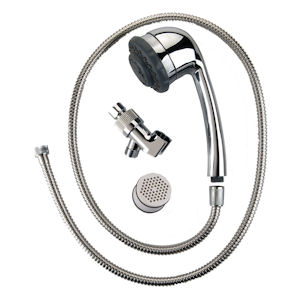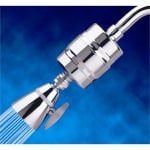We get questions about chlorine all the time. Usually people want to know if their water has any chlorine in it, how much chlorine it contains, how they can reduce the chlorine in their water, why their water has chlorine in it, and if the chlorine in their water poses a health risk.
Today’s ‘question’ hits a lot of those same points in a new, and somewhat confusing manner. It comes from TamTom18894: “Our shower water contains a lot of chlorine and we think it too high. Yes?”
Not sure how TamTom thinks we will figure out the answer to their question since we have no interest in going to their home and testing their shower water… so we will, instead, discuss simple ways to test chlorine levels in tap water so they can figure out the answer on their own… and then list a few ways to reduce the levels of chlorine that they find.
First, test the water for chlorine residual. The simplest method we know of requires very little time and tests for both free and total chlorine at the same time. The WaterWorks 2 Free & Total Chlorine Test Kit provides fast, dependable results for both free and total chlorine concentrations in water within a minute.
For those who prefer a more ‘traditional’ method, such as a wet kit that uses DPD as its reagent, you probably either already have a kit you can use or you know where you can get one… but did you know an easier method of getting the DPD into your 10 mL sample exists?
If not, then you really ought to check out the DPD-1 ReagentStrip Delivery System which adds a precise dose of DPD-1 to a 10 mL sample without the need for crushing tablets, working with hard-to-open powder pillows or counting drops of messy liquids.
For more precise results, some people turn to meters such as the eXact Chlorine Photometer which can test both free and total chlorine concentrations from 0 to 11 ppm w/ no tablets to crush, drops to count, or powders to mix.
Once you know how much chlorine you have in your water, and what variety of chlorine you have in your water, you can then set about the task of selecting a water filtration device that will best address your individual water quality needs.
Removing free chlorine from shower water
The easiest way involves adding an inline shower filter such as the Sprite High Output Shower Filter which you place behind your existing shower head. It removes: 98.9% of free chlorine, rust from water, sulfur smell, and bad odors. Additionally, it reduces iron oxide, chlorine vapors, and scale build-up on shower surfaces.
Don’t already have a shower head? Need an excuse to get rid of your existing shower head? You can get the same NSF / ANSI 177 Certified shower filter pre-fitted with a good looking, 2.5 GPM shower head. The Sprite High Output Shower Filter (-A) comes in three finishes (brushed nickel, chrome and polished brass).
Removing combined chlorine (chloramines) from shower water
Many devices will claim to remove combined chlorine, total chlorine and/or chloramines. We want you know that in our experience (thus far) we have yet to come across a shower filter that will perform that task. Inline shower filers simply do not have the required amount of filtration media required to do a good job removing chloramines from shower water.
Chloramines have a high amount of chemical stability and as such require special consideration when attempting to remove them. Typically a device capable of effectively reducing chloramines (combined chlorine) levels in drinking water will have a relatively large media bed of Granular Activated Carbon (GAC) and/or a specialized ion-exchange resin.
Larger media beds mean more time in contact with the filtration media intended to remove the chloramines.
We have rumors of ‘catalytic granular activated carbon’ (cGAC) but have not, as of yet, learned enough about it to discuss its merits and/or shortcomings.






